Choosing Quality Cucumbers for Fermentation
I suggest using one of three types of cucumbers when making fermented cucumbers. First, English cucumbers, the long cucumbers normally sold tightly wrapped in plastic, work well. The second is pickling the shorter, bumpy, lighter green cucumbers. Third is the Persian cucumber (my favorite), also known as teeny tiny or cocktail cucumbers.
Do not use slicing cucumbers for fermentation. These are very smooth, dark green cucumbers. They’re usually fat and long. Most slicing cucumbers will turn into a soggy mess through the fermentation process. Slicing cucumbers are also normally wax-coated, which disrupts the fermentation process.
Here’s my checklist for choosing good cucumbers:
- Density: The cucumber should feel heavy, like it is hydrated and has turgor pressure. It should not feel hollow, like yellow squash, if you tap your finger against it.
- Check for surface mold: Look for indentions and soft spots in the cucumbers. You do not want to buy a squishy cucumber. Cucumbers near molding will have dark, small, circular indentions or black “pocks” on the surface.
- Small is Better: The bigger the diameter of the cucumber, the soggier your pickles will be. For English cucumbers, look for one with a smaller diameter. If you are buying pickling cucumbers, go for the smaller dainty cucumbers. If you can find cocktail cucumbers, they will work fantastically.
- Color: Pickling cucumbers should be predominately green with streaks of yellowish-green. English cucumbers should be a solid medium green color.

Fermenting Sliced Cucumbers Two Ways
How you slice cucumbers impacts how the pickles hold up during fermentation. You should always remove the ends of cucumbers and not include the ends in the fermentation. The blossom end of cucumbers contains enzymes that can soften the cucumbers.
There are two slicing techniques I recommend when fermenting cucumbers into pickles.
For pickle chips, a ripple-cut pickle holds up better than a straight-sliced pickle. You can get a cheap and simple ripple cutter by clicking here.
I also suggest fermenting pickle spears or halves, which hold up even better than pickle chip slices. Spears and halves can be cut with a regular knife.
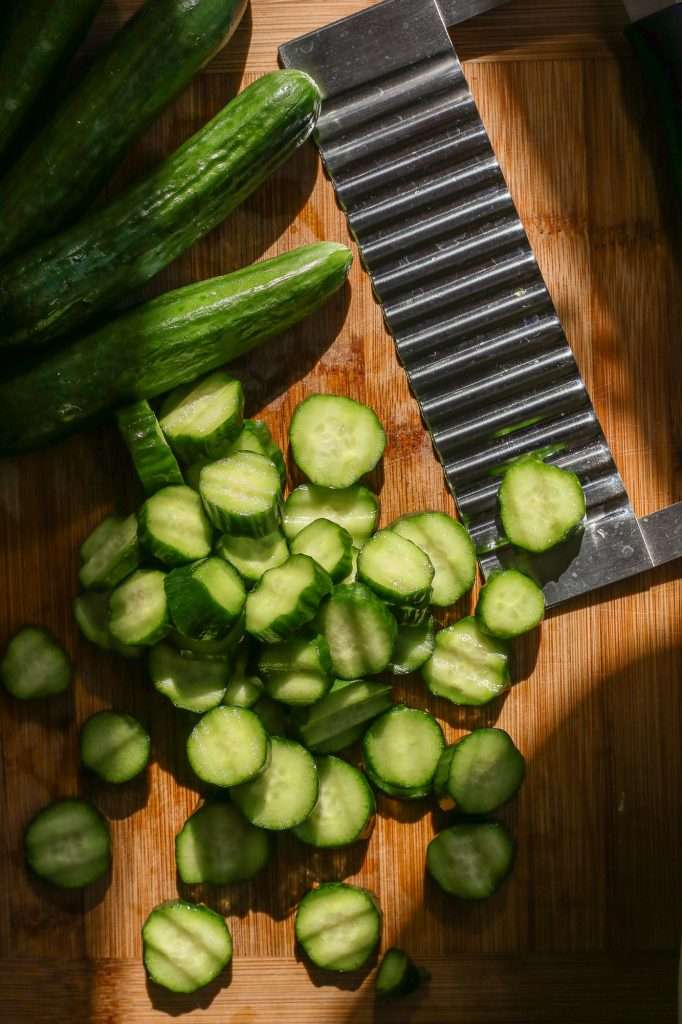
The Benefits of Fermented Cucumbers
Have you ever heard of GABA? It stands for Gamma-aminobutyric acid. It is a naturally occurring, non-protein amino acid that works as a neurotransmitter in your brain. GABA is studied and produced for its multitude of benefits:
- relieving anxiety
- improving mood
- inhibition of cancer cell proliferation
- reducing symptoms of premenstrual syndrome (PMS)
- aiding in attention deficit-hyperactivity disorder (ADHD) treatment
- lean muscle growth
- stabilizing blood pressure
- relieving muscle pain
Well, it turns out that microorganisms produce GABA in multitudes during the lactic acid fermentation of vegetables! This is especially true in fermented cucumbers.
Biologically synthesized GABA is more usable by the human body than chemically synthesized GABA. So if you need a mental wellness boost, try eating some fermented cucumbers.
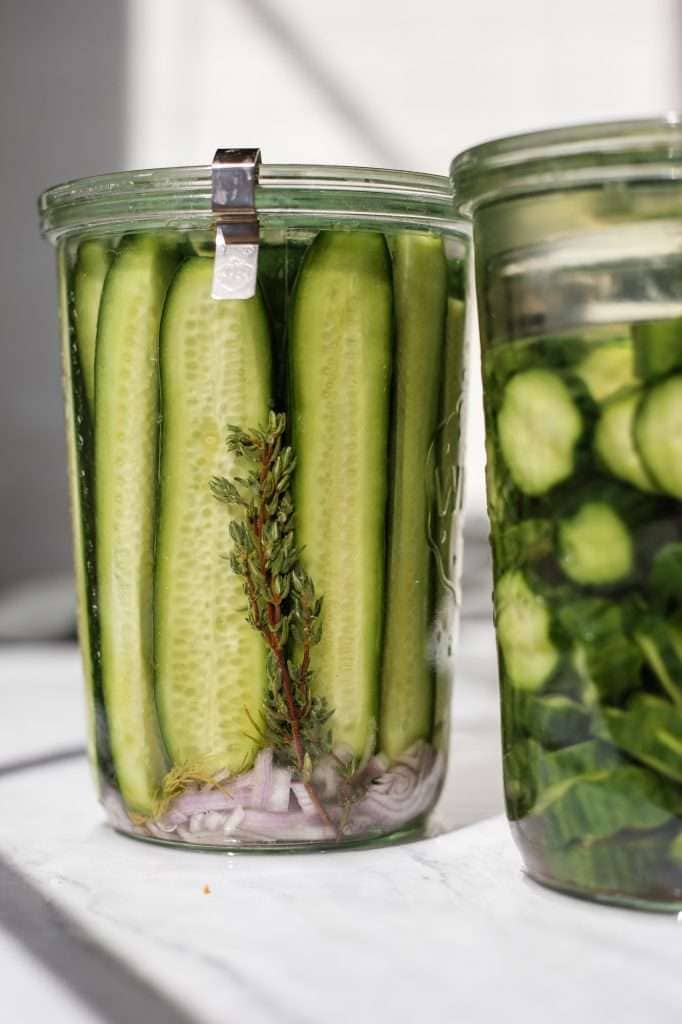
Probiotic Bacteria in Fermented Cucumbers
Cucumbers naturally have a lot of Lactobacillus plantarum on their surface. This means that cucumbers ferment a little faster than other vegetables. While cabbage takes four weeks to ferment, pickles take about two weeks.
You can ferment pickles for four weeks for extra sour flavor. This abundance of Lactobacillus makes fermented pickles excellent for gut health.
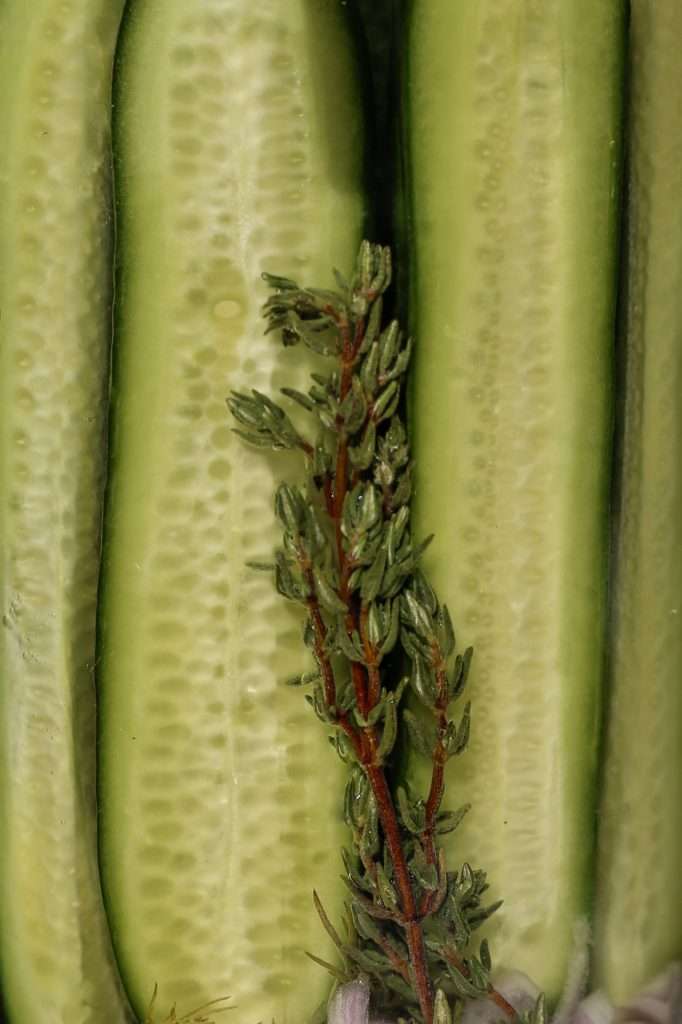
Preventing Sogginess When Fermenting Sliced Cucumbers
To help prevent sogginess, start with cold cucumbers and a 3.5% total salt concentration. The most important thing you can do to keep your fermented pickles crisp is to use at least 3.5% total salt.
You can add bay leaves, sencha green tea, and grape leaves for tannins. You can also try adding calcium chloride salt to pickles, which is very effective at keeping things crunchy. (Some sources of calcium chloride are natural from limestone… and some are chemically produced. I suggest researching this salt and deciding if you’d like it in your food).
Don’t forget, as mentioned above, how you slice your cucumber matters. Stick to ripple cuts or spears/halves for the best results.
If you still end up with pickles that just are not as crisp as you want, use them to make some delicious Fermented Pickle de Gallo!
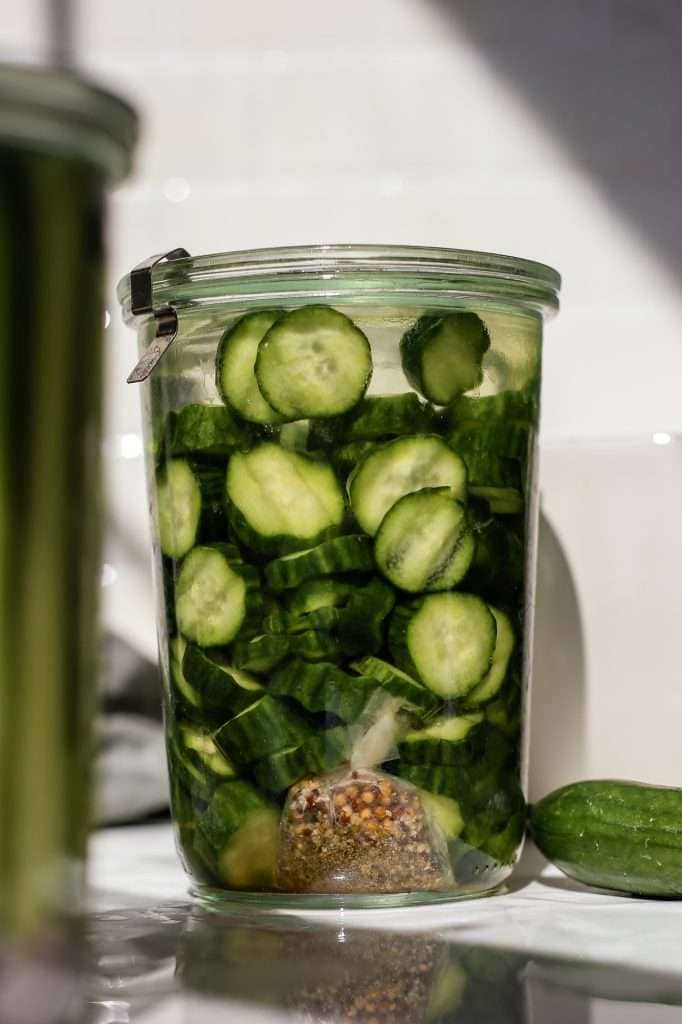
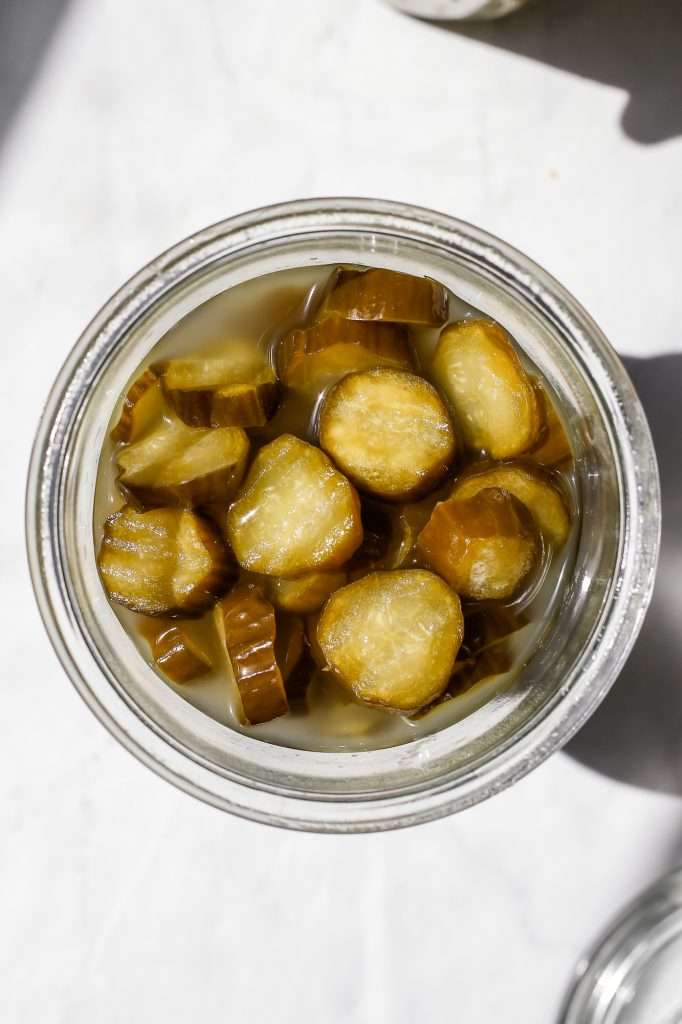

Supplies You Need for Fermenting Sliced Cucumbers
Here is the equipment you will need to make it:
- 32-ounce Wide Mouth Mason Jar
- Fermentation Weight
- Standard Metal Mason Jar Lid (this can rust in the presence of salt)
- OR Rust-Free Plastic Lid
- OR you can use a Weck Jar (without the gasket; only use the clips to secure the lid)
- Sea Salt
- Scale
- Mixing Bowl
- Ripple cutter
If you would like to read more about the best jars and lids for fermenting vegetables, click here. For this recipe, you will also need pickle spices. CLICK HERE for My Easy Homemade Dill Pickle Spice Blend Recipe
Preventing Spices from Floating
If using dry spices in pickles, you can easily stop the spices from floating at causing issues. Put the spices in a small piece of cheesecloth or a tea bag and tightly tie it closed.
Nestle the little spice pouch at the bottom of the jar, under the cucumbers. You will still get all the flavor from the spices without anything floating.
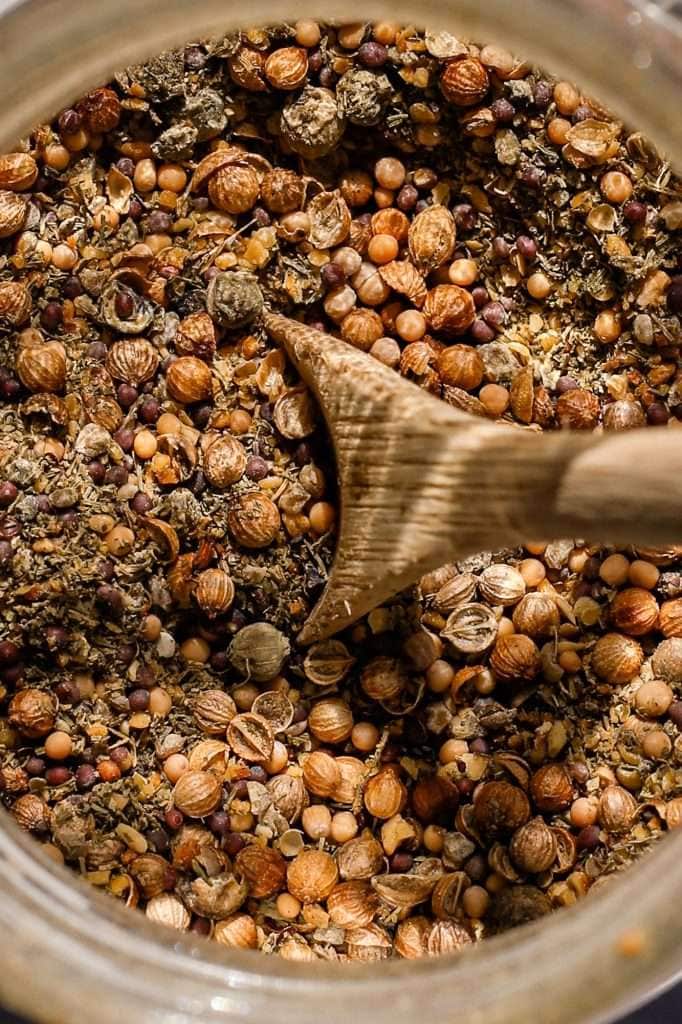
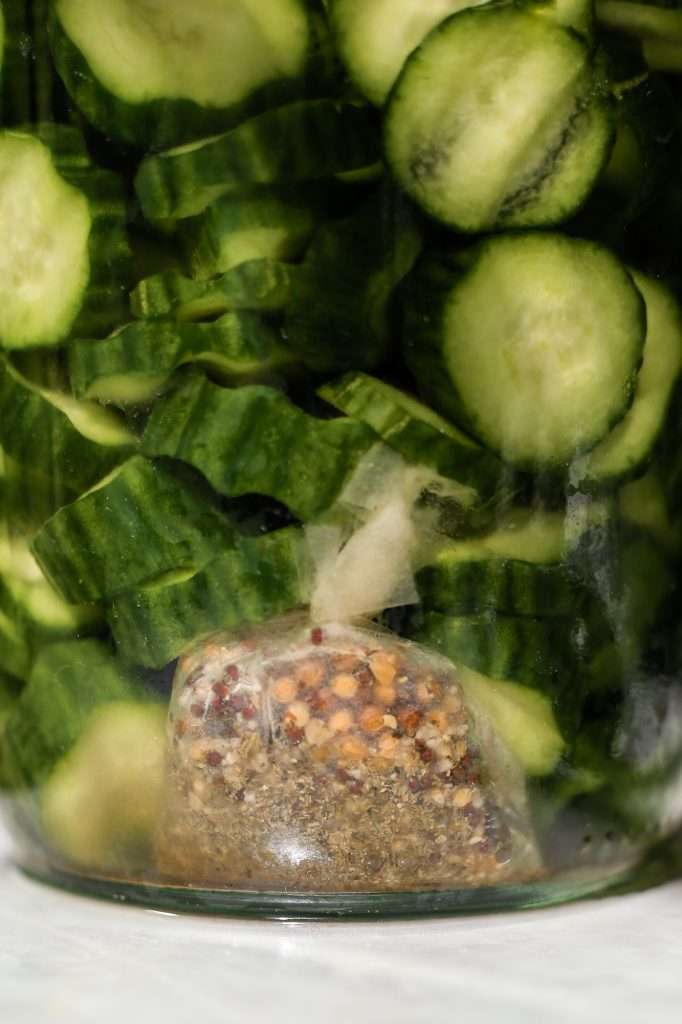
Fermented Cucumbers and Mold
By following directions, you should not encounter this problem. Note that most “vine-growing” wild-fermented vegetables can have pellicle growth. This is normal for vegetables that are also fruits as long as it does not look furry, pink, blue, black, green, or magenta.
A safe pickle pellicle is normally opaque, off-white, and crinkly. If you have surface growth like this, it’s a harmless mixed colony of wild yeasts. It’s not “mold”…you can skim it off the top and still eat your pickles. See the two pictures below as a reference for what a normal pickle pellicle looks like.
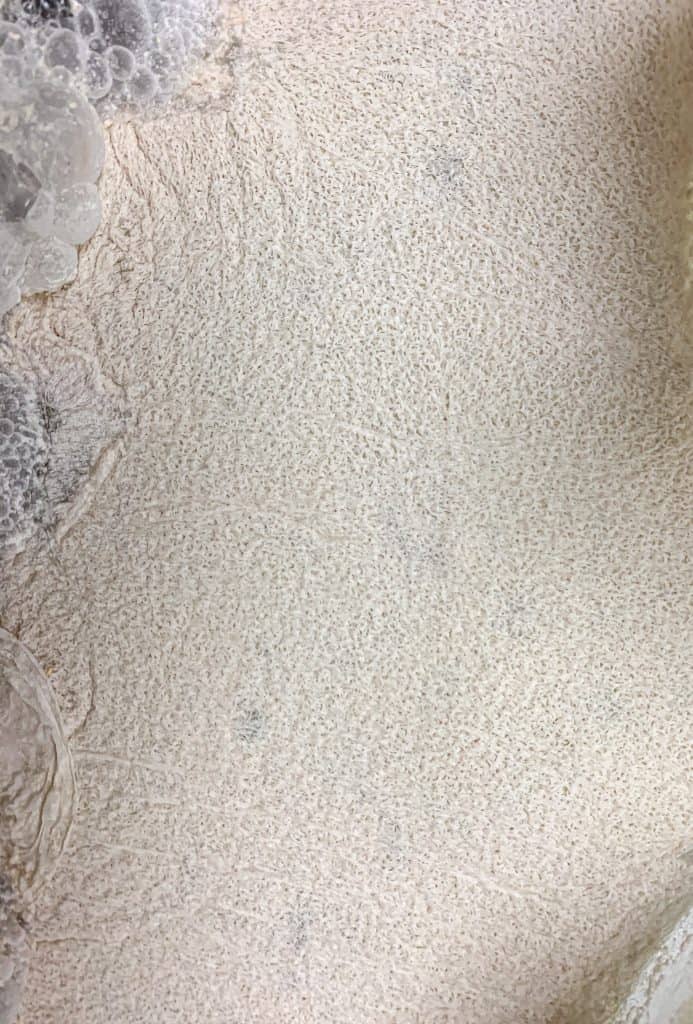

Fermented Cucumbers Timeline
We tracked our fermented pickles throughout the fermentation process. If you follow our recipe and directions, your timeline for fermented cucumbers should approximately match ours. This timeline is for fermenting cucumbers at 72-78 degrees F. The process will be slower in colder conditions and faster in warmer conditions.
24 – 72 hours: All contents in the jar should be submerged beneath the brine. At this time, there are still Gram negative bacteria and possible pathogens present.
72 hours – 7 days: After 72 hours, you should start to see lots of bubbles. You need to burp the jar if you are using a standard mason jar and lid. Cucumbers in this stage should change color from vibrant green to pale olive. You will also notice the brine become very cloudy. Leuconostoc bacteria begin to thrive and produce a lot of carbon dioxide and acetic acid. Gram negative organisms die off during this time.
7 – 12 days: Bubbles in the brine will decrease as the ferment leaves stage two and enters stage three. The mixture will become cloudy and start to develop a pleasantly sour smell. Lactobacillus species are most abundant during this time period.
12 – 14 days: Lactobacillus make up the majority or all of the microbial population. They produce copious amounts of lactic acid, and make the fermented cucumbers smell even more pleasantly sour. This is the time in which the vegetable mixture becomes preserved. At this time, you can smell and taste test.
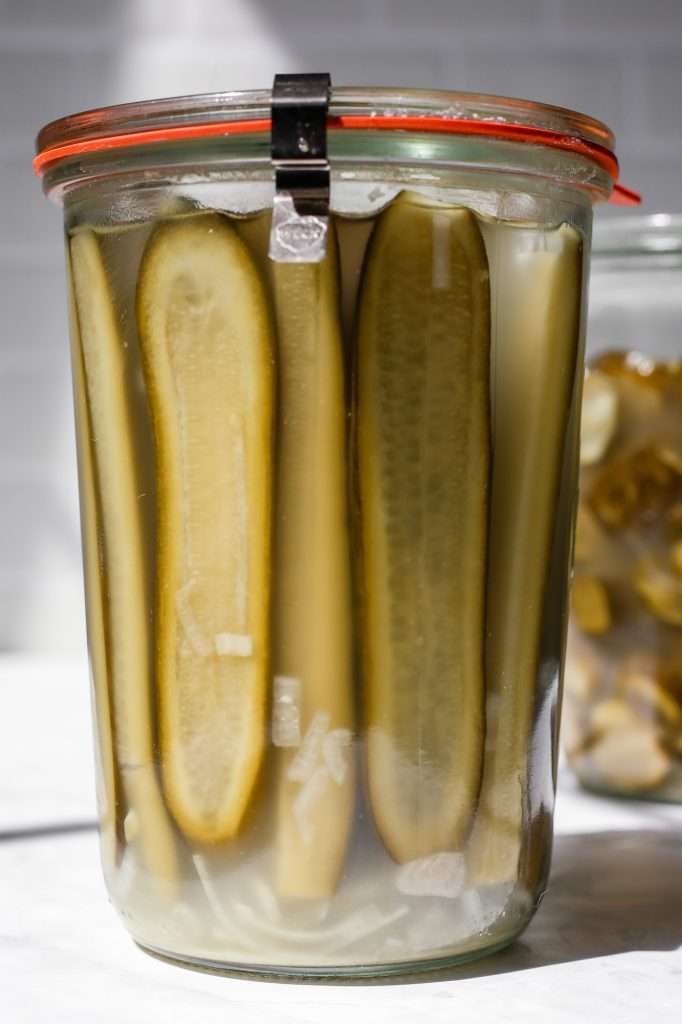
Fermented Pickles Recipe Tips
During the first few days of fermentation: carbon dioxide and bubbles will be produced. Sometimes jars will become full of liquid, and this liquid can seep out. You can store the jar in a bowl or on a plate to catch anything that seeps out.
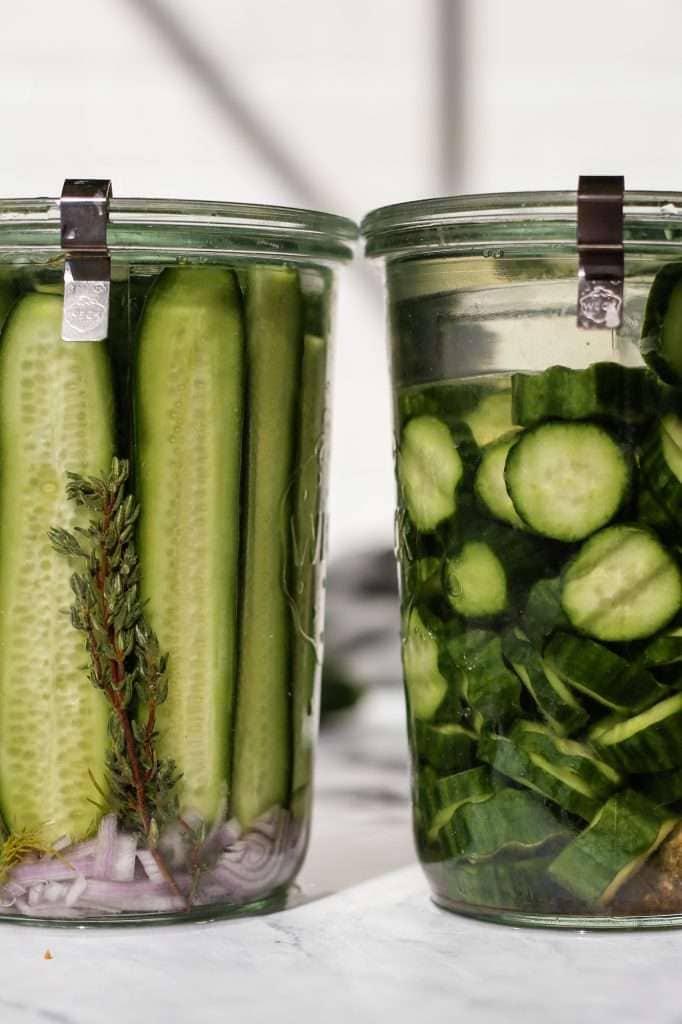
Remove the lid and tamper everything using a gloved hand, tamper, or spoon if necessary. Make sure everything remains submerged below the brine during fermentation. You can take the lid off regularly and rinse it off if it is dirty.
Fermented cucumbers should smell pleasantly sour and more smooth than a vinegar pickle. Never eat fermented vegetables that smell repulsive or like alcohol.
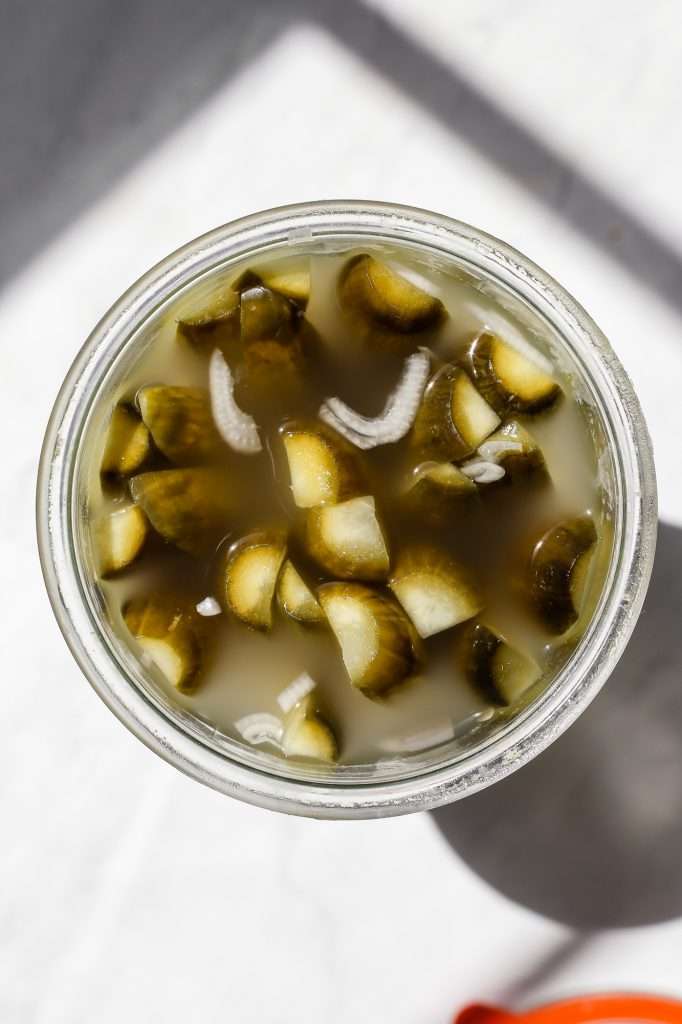

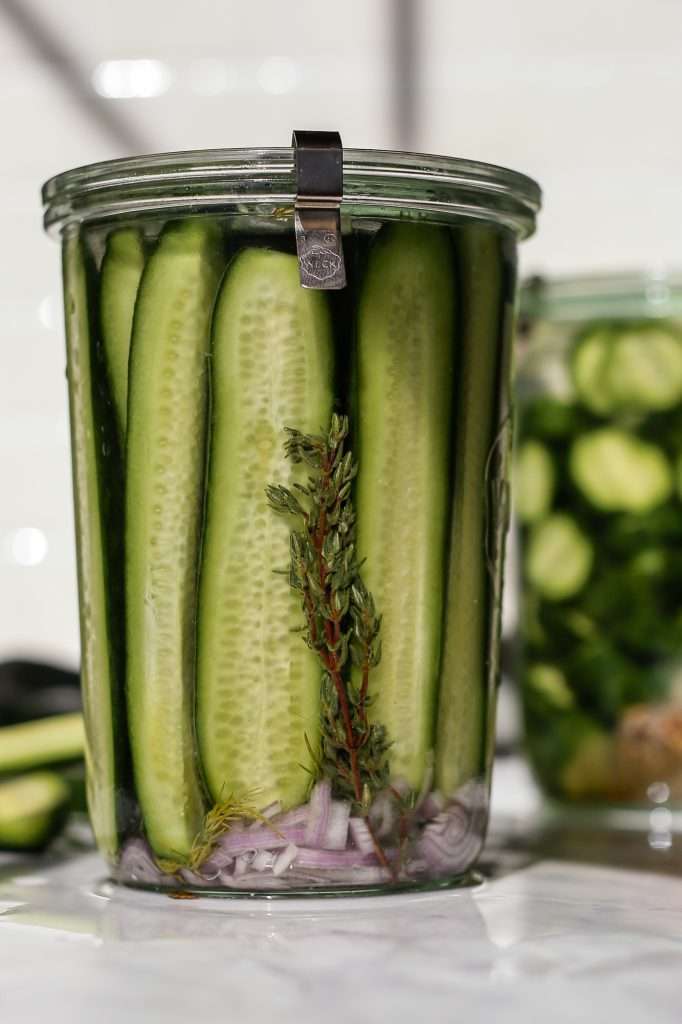
Fermented Cucumbers: Fermenting Sliced Cucumbers Two Ways
Tired of soggy fermented pickles? This fermented cucumbers recipe makes it easy to ferment crunchy and crisp pickles. Learn the best techniques for fermenting sliced cucumbers ready to eat in just two weeks!
- Prep: 20 minutes
- Total Time: 336 hours 20 minutes
Ingredients
- 460 grams cucumber
- 320 grams water
- Fresh dill
- 20 grams Minced shallot
- 1 thyme sprig
- 28 grams salt
- 3 teaspoons pickle spices*
Instructions
- This recipe at 1x works best with a 32-ounce wide-mouth jar. Please see the equipment recommendations above. Please use the right type of cucumber. The recommendations can be found in the first paragraph of the blog post. Please also read the slicing recommendations.
- Wash all of your fermentation equipment (jar, weight and lid)
- Wash your cucumbers in cool water.
- Slice your cucumbers either as ripple cut chips or as spears/halves.
- Place your kitchen scale on the counter. Turn it on and set it to weigh in grams.
- Weigh out the designated amounts of all your ingredients.
- Add everything to the mason jar. (It helps if you put anything cut small, like shallots, below the cucumbers to keep them from floating)
- Add in any spices (If using dry spices, you can avoid them floating to the surface. Place the spices in a small piece of cheesecloth or tea bag and tie it closed. Nestle the little spice pouch at the bottom the the jar, under the cucumbers. By doing this, you will still get all the flavor from the spices, without anything floating.)
- Place the lid on the jar, and secure. Shake the jar vigorously for 2 minutes to dissolve all the salt.
- Remove the lid. Place your clean fermentation weight in the jar making sure to submerge the cucumber pieces and weight fully in the liquid.
- Secure the lid to the jar (you don’t need to significantly tighten it, close it).
- Let the cucumbers ferment for 14 days at room temperature. Set the jar in a glass dish to catch any spills.
- If you tighten the lid a lot, you should burp the jar daily when it is bubbling.
- After 2 weeks, remove the fermentation weight and smell and taste test. Your fermented pickles should smell pleasantly sour and taste tart and salty!
- Store in the fridge.
Notes
- This recipe at 1x is for a 32- ounce jar.
- You can use fresh herbs only, or dry spices only, or a combination of both. CLICK HERE for My Easy Homemade Dill Pickle Spice Blend Recipe
- You can add other spices like allspice or clove for sweeter flavor profiles, or chili flakes for spice.
References




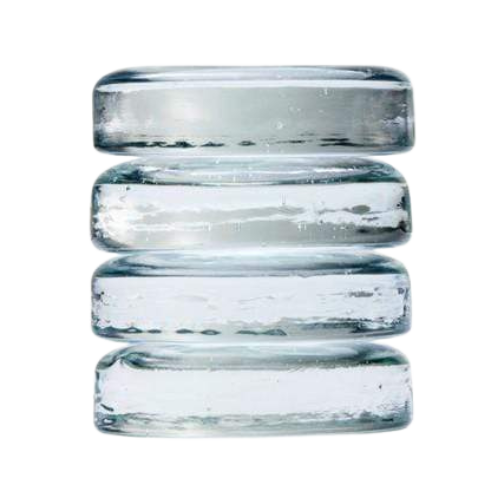
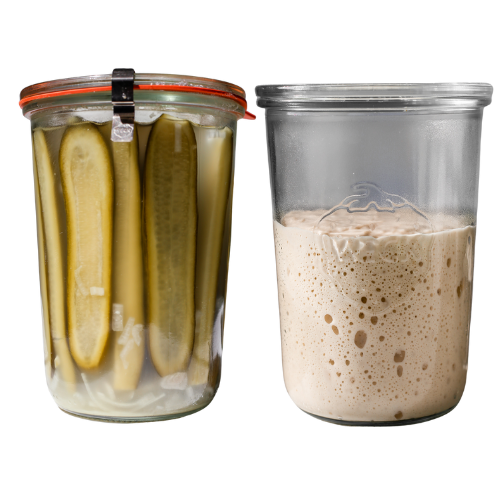
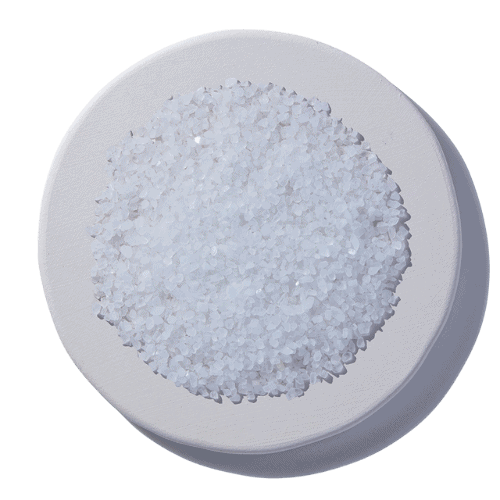
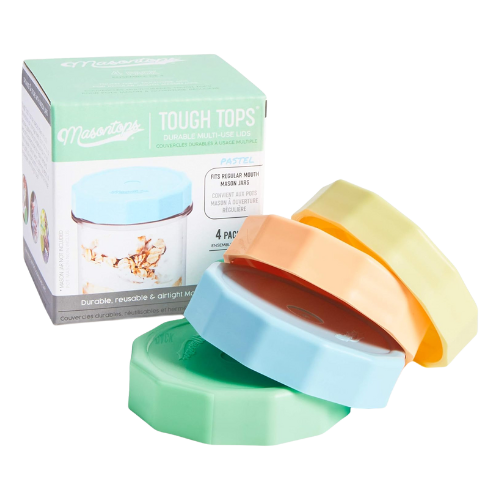
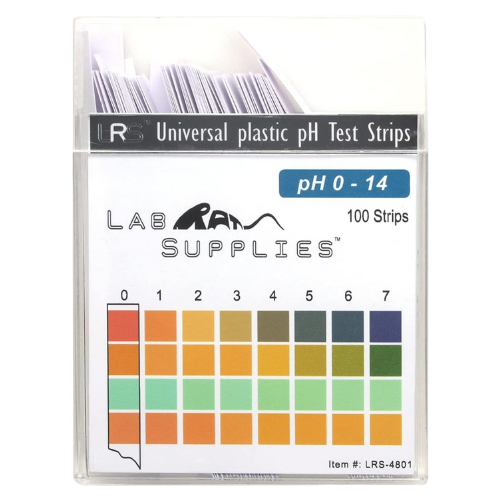













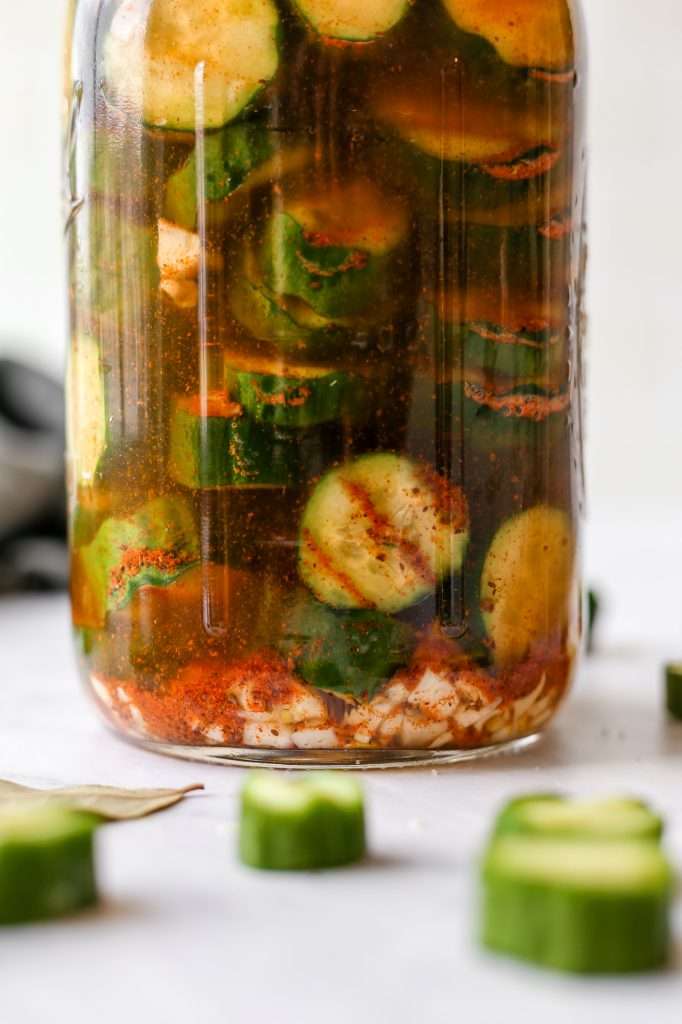

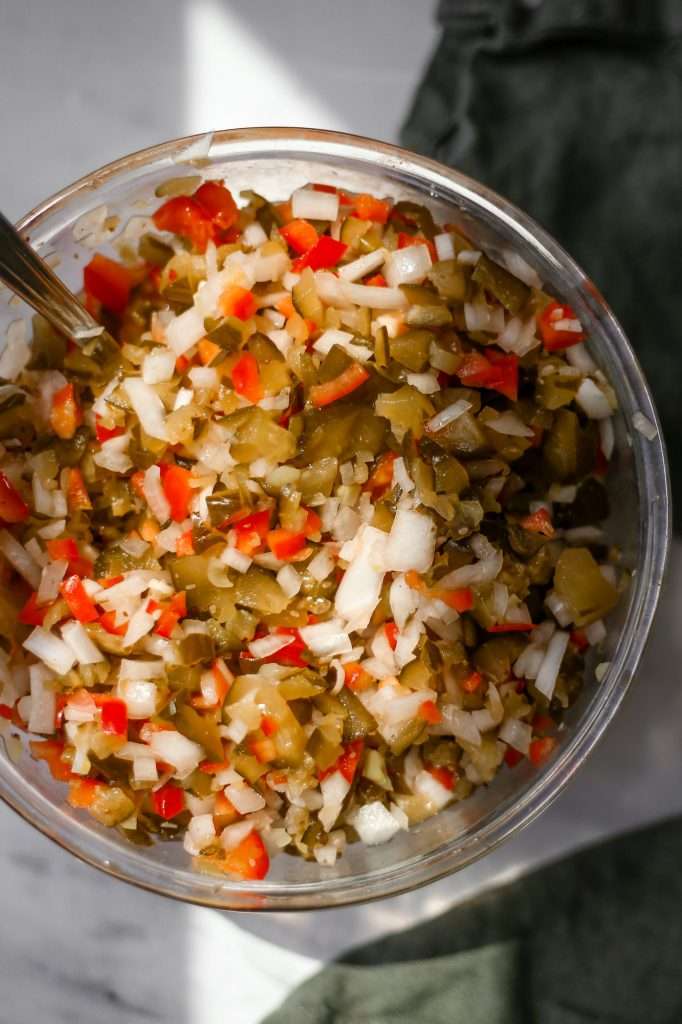

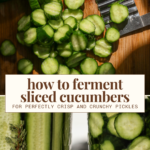
Thank you for sharing this recipe! I am ready to give it a try, but when do I add the garlic, dill, and other seasonings? Also, how much faster do you think it will ferment if I add a little culture from another ferment?
Hey there, you add in all the spices right after you add in the salt. You shouldn’t add in culture from another ferment to this recipe. It will not speed things up, and it will disrupt the process of bacterial succession. Doing this usually leads to soggy pickles.
Great! Thank you!!
this was exactly my question! Thank you both ladies for saving my time 🙂 Super good recipe btw!!! I have made already 10 batches this year and they all worked out amazing!
I’m happy to hear that you are loving the recipe, and all your batches are amazing!
similar question. I have a jar of unused brine in the fridge. I.e. my jars are 24 ounce and I do small batches. didn’t need all the brine to cover.so, can I use it? does it ever go bad?
How do you prevent the diced shallot from swimming up to the sides of the weight, above water?
like in the pictures, I usually put it in the bottom of the jar so all the pickles hold it down.
I attempted your recipe last night for the first time with a couple of changes. I split the recipe into two wide mouthed 16 oz jars(what I already had on hand.) When I attempted to put my glass weights in they wouldn’t fit! Ahhhh! Is mold at the top inevitable without a weight?I’m using a self breathing lid. Thank you for your informative site and beautiful photos!
What do you mean they wont fit? like, the weight is too big to go in the jar or the cucumbers take up too much space? Everything must stay submerged in the brine, that’s the most important part. It doesn’t matter if you have a special lid, you still need a weight. Also, if its one of those silicone lids, I really do not recommend those. They cause a ton of issues.
My store didn’t have dill. Would it be ok to add it in within 24 to 48 hours after the rest of the ingredients? I have to thank you for your clear information about fermenting. I was hesitant to ferment before reading your blog, all the conflicting information was overwhelming. I have read all your blog posts, and every one is so helpful. Thank you!
I’m so happy to hear that our blogs helped to remove your fear of fermentation! You are able to add in the dill in that time frame. I just wouldn’t add it in after the 72-hour mark.
Thank you so much!
Hello, thank you for sharing! Do you think it would be ok to double the recipe as I have 32 ounce jars? Thanks in advance!
absolutely! My dad makes his pickles by doubling this recipe. You can also press the 2x button on the recipe card.
Hi There and thank you for the recipe. This will be my first go at fermenting my cucumbers and I was so happy to stumble upon your site. When it comes to the salt which brand do you recommend using in this recipe? I looked up unrefined sea salt and so many options popped up on Amazon but I didn’t know which to choose. Any suggestions are appreciated 🙂
We’re happy that you found us here! For salt, check out a company called Salt Works. They have the best sea salts in my opinion, and this is the company we use to craft our fermented vegetables. Any of their salts should work great.
Hello! I saw instructions on fermentation that allowed the use of some liquid from a completed ferment as a starter for a new ferment with reduced salt content. Whey and kombucha were listed as alternative starters if one didn’t have a jar of fermented vegetables on hand. Is this acceptable and safe?
Hello!
Good question. The short answer: no.
In my opinion, the fermentation of cucumbers is safe and healthy when using the recipe in this blog as I wrote it.
1. I do not suggest using whey in fermented vegetable recipes.
2. I would never use kombucha as a starter for fermenting vegetables. Kombucha is a vastly different type of fermentation and involves yeasts and microbes that are not a part of the vegetable fermentation process.
If you would like to create safe, low salt fermented pickles:
I suggest making this recipe exactly as stated. Once fermentation is complete, pour off half the brine and replace it with raw apple cider vinegar. This will result in completely safe, probiotic pickles with about half the salt content.
Kaitlin, how will the substitution of apple cider vinegar for the pickled juice affect the probiotic organisms (bacteria colonies)? Thanks.
As in replacing some of the brine with ACV after fermentation? It doesn’t influence them at all. The pH stays around 3.5 and Lactobacillus are fine living in the presence of acetic acid and acetic acid bacteria.
Is 200 Grams correct for English cucumber? At 1/2 inch slices, that’s only 12 pieces?
Thx
yes. This is correct, for a 16-ounce mason jar. (check the notes) If you are using a bigger jar, you can double or triple the recipe accordingly using the 1x, 2x, 3x options on the recipe card.
Is 200 Grams correct for English cucumber? At 1/2 inch slices, that’s only 12 pieces?
yes. This is correct, for a 16-ounce mason jar. If you are using a bigger jar, you can double or triple the recipe accordingly using the 1x, 2x, 3x options on the recipe card.
Fun fact: In the region of present day Poland that I’m from, we used to have tradition of fermenting dill cucumber pickles in barrels sunk into rivers for whole winter (making fermented cucumber pickles was a common part of preparations of food reserves for winter, so was making sauerkraut). But it was decades ago when water was much cleaner. Nowadays we use mostly stoneware if we are preparing “low-salt” variant that is fermenting them up to 2 weeks when they still preserve crispness.
As for typical additions to pickles that is used in Poland (and few other countries of region) it would be
– horseradish (around 10cm stripe per mason jar)
– garlic
– dill
– bay leaf
– allspice
Hello Kaitlynn, thank you for sharing this dynamite recipe. I ferment currently in the Philippines, all types of veggies. My pickles (cucs) come out super sour. How may I make them less sour while letting them ferment for 2 weeks? Also, i use coriander seeds, should the weight be the same? Is kosher salt acceptable? So to be clear, the 4% is based upon the weight of the veggies as well as the water? I’ve been using 5% previously but only weighed out the water. Also, it is 85 degrees here so they ferment quickly! My pickles come out not very crispy, I use bay leaves for tannins, any other ideas?. Thanks for your post and expertise.
Sincerely,
Justin
I don’t suggest trying to make them less sour. the pH of fermented pickles is a safety standard, and raising the pH can cause issues.
Mostly all types of NaCl work well in vegetable fermentation, so kosher salt is fine. Yes, 4% total salt concentration is based on the weight of cucumbers and water… This is because the weight of most vegetables is about 98% water. For crispier pickles, you can try cooling down the temperature in the fermentation environment, and start with cold cucumbers. Warmer temperatures, such as 85 degrees, can increase pickle softening. Also, make sure you are using the right kind of cucumber and slicing the cucumbers in a way that encourages a good texture (tips for this can be found at the beginning of the blog post).
I’m wondering if other tea leaves could be used to help ameliorate the sogginess, e.g. regular green tea or black tea leaves, or even something like Earl Grey (interesting flavor). Thoughts?
Yes! Any type of green, black, oolong or white tea leaves can be used. You can try flavored teas, but how fermentation impacts those flavors will be variable, so you’ll have to experiment. I personally wouldn’t use earl grey since it contains oil of bergamot. Citrus oil flavors can be quite soapy and astringent after fermentation (same goes for incorporating citrus peels into fermentation).
Kaitlynn, I am on day 8 of fermenting cucumber spears from my garden- using this exact recipe. I am using a fermentation lid that allows the oxygen to release from the jar. Is it accurate that I need to wait until days 12-14 to taste my fermented cucumber spears while using this lid vs using a regular, plastic mason jar lid? Every time I try to ferment, I get nervous at this point bc I worry I am going to facilitate mold growth. The 7-8 day mark always makes me nervous! The 16 oz jars are sitting off to the side in the proper temp, out of sunlight. Should I open the jars for any reason if I have the plastic lids with the rubber center that release the oxygen? There is so much extra liquid in my jars right now. I assume this is normal and that I will be able to drink this brine after fermentation is completed to benefit from the probiotic bacteria (like I do your pickle juice brine)?
Hey there,
Using a special lid doesn’t change the timeline. I still recommend 14 days of fermentation for pickles. I hope you are using a fermentation weight to keep all the cucumbers submerged in the brine. That is the important part, special lid or not.
I’m not sure if I know what kind of lid you are describing, there are so many kinds these days. If you are using one of those silicone lids with the nipple on the top, I suggest switching to a clean regular solid mason jar lid now. If its some sort of solid plastic lid with a little orange airlock thing in the middle, and all your pickles are clearly submerged in the brine, just leave it alone.
It’s good that there is a lot of brine. The brine is delicious! You can absolutely drink it for probiotic benefits.
Thank you, Kaitlynn. Yes, I am using a glass fermentation weight in both 16 oz jars. Also, the lid is an “easy fermenter lid” (the set actually came with an oxygen extractor, but i haven’t used the extractor at this point. Should I use the extractor if I have not opened the jars at all? I understood that the only reason to use it is if I open the jar and then reseal it- to remove the oxygen). The lid itself is a hard, black plastic lid with an orange airlock valve in the center. It has a little dial with numbers on it to help track the fermentation days. The cucumbers are fully submerged below the weights- however, there is liquid and some of the spices floating on top of the weight. So, the weights are about a 1/2 inch below the top level of the liquid and the cucumber spears are below the weight… does that make sense? With this specific set up, can I just leave the cucumbers fermenting through 14 days without opening the lids/burping, etc.? And, then at 14 days, I should taste the brine and cucumbers, correct? Then, store in the fridge? Thank you so much!
Thank you for this detailed explanation! I know the kind of lid you’re talking about now. I’d just leave it alone until 14 days, no need to open it. Yes, at 14 days, remove the weight, taste test, then put them in the fridge.
what if i used a 32 ounce jar on accident but did not double the recipe?
You will just have a lot of space in the jar, it should be fine.
I have had perfect crunchy pickles every time using this recipe! I really appreciate all of the time and knowledge that go into this whole blog. I know that my end result will be not only delicious but also safe to eat and beneficial for my gut biome!!
I highly recommend doubling the batch because you will want more once they’re done
Best pickle recipe! So yummy, saves money, AND better for you!!! This recipe answered all and everyone of my questions – made it so manageable. Easy to make – most of the ingredients you will have on hand. LOVE cultured guru!!
What result can I expect from using fresh rather than dry bay leaves for this pickle recipe?
Your results should be the same, you might just have more tannins and bay flavor in the mix.
Hi Kaitlynn
I’m having trouble keeping my cucumbers submerged, I’m using the glass weights and the cucumbers can get passed on the side wider section of the jar tilting the glass weight, I do pack tightly and use blackcurrant of horseradish leaves to prevent gaps but still get problems with some jars, and when eating the cucumbers how do you keep a half empty contents submerged until empty.
You don’t have to keep them submerged when you start eating them. Once they’re done fermenting and you begin eating from the jar, you should be keeping them refrigerated and they no longer need to stay submerged all the time.
Thank you for this detailed recipe and all the careful explainers! I got some pickling cucumbers today and would like to try fermenting them. Will this recipe work for whole pickles, perhaps with extended fermentation time? Or is it important to cut them into pieces?
whole pickles work! Generally, the smaller the cucumber the better it ferments whole.
Is it ok if I use equal weight onion instead of shallot?
yep! You can evenly sub.
Hello, I’m on day 8, and little furry islands of white mold have appeared. Definitely doesn’t look like pellicle. What do you think went wrong, and do I throw it out now? Thank you…
You jar might not have been cleaned well enough, or maybe you have some floating spices, or maybe you tried to use one of those silicone lids?
Hmm I used a weck tulip jar with a glass weight (both had been just run through the dishwasher), but I’ll just give it another go, just got some fresh pickles from the farm! Maybe I will boil the glassware instead of taking shortcuts 😄 thanks!
Also wondering about mold! I think I maybe had a few floating spices, which resulted in 3 small white fuzzy floaties. Can I scoop them off and keep the ferment, or do I need to throw it all away?
I never advise eating anything that was moldy. It’s an eat at your own risk situation.
I did this recipe and after over a week did have some surface growth that I scraped off. But, at the bottom of the jar amongst the garlic and other spices was some opaque fuzzies. Pickles do not smell moldy, and after a hesitant taste test, taste pleasant. The only thing I did differently in this recipe was I used a pickle pipe instead of hurling the jar periodically. What do you think? Safe to eat?
Any opaque floaty things (sediment/cloudiness) you see in the bottom of the jar below the brine is just microbes and beneficial compounds they produce. I suggest using a solid lid and burping the jar, instead of using a silicone lid. Air can enter the jar through those lids, and the porous silicone can harbor unwanted microbes.
hey there
thank you so much for this recipe! I made already 3 batches and all turned out great (well one was a bit too salty as I used dead sea salt and the same recipe, but I do have the impression that salt tastes much saltier than celtic sea salt, anyways, they are also very tasty)
I wanted to ask – would adding baby corn into this recipe work? I have few plants in the garden ready for the harvest and I planted them for pickling, but if I actually could ferment them instead it would be pretty awesome.
thank you for your time & all you are sharing! hope to take your courses next year:)
Adding baby corn might be good! I’d probably do a mix of baby corn and cucumber. I’ve never tried it so I don’t know for sure. Let us know how it goes it you try it.
thanks a million!
will give it a try this weekend
would you actually try the same recipe with babycorn only too? I mean especially the ratios with salt
I finally got to put this together this week on 8/21 and left it on my counter. I checked it today and there’s some furry green looking mold spots on top that must have just formed and I’m so sad. I need someone to tell me I can’t just scrape it off and keep going – I can’t right? I think some of the cucumber seeds floated up and contacted the air. I scooped some out at the start but math not have done a good enough job. So sad.
What is the downfall of fermenting for greater than 14 days? I have some cucumbers from the garden that I wanted to trial with this, but we will be out of town during days 11-19. If I started them and was able to burp them during the first week as needed. maybe I could then use a pickle pipe while I was gone. Do you think it would sit too long?
Also, I am struggling to find coriander seeds anywhere? Any suggestions?
I get mine from starwest botanicals. You can leave them out.
there are no problems leaving them for 20 days. You can put them in the fridge on day 11 if you want. They will just be more sour if you leave them at room temperature longer. They should be done bubbling by day 11.
Thank you so much for sharing! Another favorite in our house now. I think we’ve made it 4 times now and they’re always gone within just a couple days of being done 🙂
Trying them this time as whole pickles!
Hello,
Can I add hot pepper slices? We love hot dills!!!!!!,
Thank you for sharing your knowledge…..
Thank you for your recipe. 1st time fermenter. Mom made pickles in a 20 gallon churn and they were the family favorite. I didn’t have oak or grape leaves so in one jar I’m testing tame blackberry leaves. Anxious to see the finished product. Also is there a method for longer term storage?
I long term store my fermented vegetable in the refrigerator.
Hi! I’m six days away from my first batch of pickles. I am so excited! They smell fantastic. I’ve already started my second batch. I doubt these will sit in the fridge long but I am wondering if they last six months in the fridge like sauerkraut or if their freshness is longer or shorter. Also, I’m one of those weirdos who can be seen standing in front of the fridge drinking the pickle juice. LOL! It’s SO good! Any problems with drinking this juice or just more probiotic goodness? Thanks a ton for this fantastic recipe!
They should last six months in the fridge just fine! I drink fermented pickle brine all the time! It’s great and full of probiotics. I suggest pouring into a little glass and drinking it, and not drinking it straight from the jar, though.
Would you do anything different if fermenting whole pickling cucumbers? I’m planning to try this recipe this summer.
No, you can follow the same directions for whole pickling cucumbers. Make sure to cut off the blossom end.
Kaitlynn, thank you for answering my previous question. My first batch is done and they are AMAZING!!! They are so flavorful and probably the best pickles I have ever tasted. Thank you! When my first batch was brewing there were lots of wonderful bubbles when I burped the jar but with my next batch, there is hardly any at all. Does that indicate a problem? Thank you for your guidance.
You’re welcome! I’m happy to hear you love the pickles!!! It’s not a problem, some cucumbers have a lot of bubble-producing microbes and some have less. As long as you see some bubbles it’s good to go. If you loved the recipe, can you leave a five-star review? Reviews are so helpful 🙂
I absolutely loved making these pickles! It was so much fun and much easier than I expected. My first batch came out so amazing and so flavorful, I’m on to the next couple of batches. I think these are the best-tasting pickles I have ever had and I am a pickle person. Thank you so much for the guidance and recipe!
Why is it recommended not to use the gasket with Weck jars?
You can use it, but if you leave it off and set the jar in a bowl, it allows the gas to escape, so you don’t need to burp the jar.
I am excited to make these! One question I couldn’t figure out from the blog – do I use both the fry pickle spices AND the thyme/minced shallot, or is it one or the other? The asterisk in the recipe confused me. Thanks so much for all these recipes!
Hi there! an asterisk next to an ingredient generally indicates that you should check the notes section of a recipe, under the instructions. The notes section has the info you’re looking for 🙂
Do you dissolve the salt first or just pour it in?
The directions are in the recipe card. See steps 10-12
Hello and thank you for your recipe! If the pickles just taste super salty, did I do something wrong? 😆 I also didn’t have “pickling spices” or anything so I’m not sure if that impacts the flavor.
So the taste of “saltiness” is different for everyone. What you think is super salty, someone else might think is regular. So you probably didn’t do anything wrong, you’re just not used to the flavor of naturally fermented pickles. You may also be tasting lactic acid flavor mixed with salt. Lacto-fermented pickles aren’t going to taste like vinegar pickles.
That’s good to know, thank you! I usually like things pretty salty so I was like yikes! I was worried I didn’t dissolve the salt or something went wrong. You’re right though, it could just be something to get used to. I had quite a bit of cucumbers this season, so I’ve been experimenting with a lot of techniques. Everything is definitely different homemade!
Hi, I have Melitta brand paper tea bags, would that work for spices? Thanks for all your recipes!
Cathy
yes those should work!
mine are currently fermenting!
i have marketmore cucumbers and Eureka pickle cucumbers that i’m growing from the farmers market.
i can’t tell which ones are which bc they all look the same. do you know if both of these will work?
i think i’m using the marketmore currently. i picked them when they were smaller.
i can’t wait to see what happens!
Hey there sleepy head… oops, I meant to say, lovely Kaitlynn.
I found your deliciously tempting Fermented Cucumbers recipe blog reading your email today. Which seems incredibly easy to do, super healthy and a delicious delight. I particularly love your microbiologist infused nuggets of really interesting and helpful information so a BIG thank you, Kaitlynn.
I’ve been learning as much as possible about fermentation and I must say, your microbiologist qualifications give me confidence, so much that I am keen to have a go for the very first time. I’ve never fermented before so this will be my very first time.
One thing that’s been holding me back is my severe OCD. I must literally wash everything many times with soap and water, including vegetables. My concern is, the fermentation process will not work because I suspect the friendly bacteria is washed away when washing the cucumbers with soap and water. Am I right in thinking this, what do you think, Kaitlynn?
Alternatively, if washing with soap as I do, discourages/prevents fermentation, do you know of another method to initiate fermentation?
Hey, kudos to your husband, Jon’s photography adds a lot of value and meaning to the concepts and information you are explaining.
Have a lovely day,
Julian
Hi there! Washing vegetables a lot can significantly reduce the wild fermentation microbes. But if washing things really well makes you more comfortable, you can keep doing so and try using a starter culture with my recipes! I suggest this one (link to vegetable fermentation starter cultures)
After washing the cucumbers with soap and water, I’m happy to report they fermented beautifully and taste delicious. Thanks, Kaitlynn 😃
So glad to hear this!
Thank you so much for this detailed post! Is it necessary to sterilize jars or will doing so kill off helpful bacteria? Can I pressure can these rather than storing in the fridge? Also, some recipes recommend fermenting for five weeks and others for 1 week. I am wondering why. Thanks!
You should clean all your equipment before getting started. I’ve never pressure-canned fermented vegetables, you would have to cook them, then hot pack them, then pressure can, and doing so will kill all the beneficial microbes. All my recipes have a different timeline based on the vegetables being fermented because all vegetables have a different microbiome and ferment at different rates.
The tool to scale the recipe is not working for me. Tried on my phone and iPad.
Thanks for letting me know! I’ll contact the recipe plug-in developer and see what’s up.
Hello and thank you for this recipe and all you do! I’m really excited to get started.
Would I be able to add in some peppers to make these a little spicy? Like a jalapeño or habanero? Trying to replicate my boyfriend’s favorite pickles. He’ll buy already fermented pickles and add the peppers to the container and keep in the fridge, but I’d like to ferment everything together. Based on your other blogs I’m wondering if the peppers would alter the process? Or should I add them in after fermentation when they’re going in the fridge?
I’m also generally wondering if I can add flavoring to this base recipe and just redo the calculations for the added things like garlic or onions or peppers etc?
Thank you in advance!
Thank you in advance!
You can add a few pepper pieces or a little garlic and onion without needing to change the recipe calculations. Just sub a bit of the cucumber weight with some peppers, garlic, and onion and it should be fine.
Perfect thank you!
Can I add some Fresno peppers and garlic, and just take the weight of peppers and garlic off the cucumber weight?
Many thanks 😊
I have made these and they came out like suggested yay! but I’m not used to the salty taste, is it possible after fermentation to swap half the brine for vinegar and store in the fridge in order to make it more palatable?
Also would doing this affect the amount of beneficial bacteria?
Hi There,
Thank you so much for sharing your recipes, I am eager to get started!
Just wondering, does it matter what type of water I use? Is tap water ok, or should i buy some distilled water?
Use whatever kind of water you drink!
Hi there! I’ve been making fermented pickles for years the super old-fashioned way–in a 3-gallon crock. Always turn out great, but THIS batch–the recipe calls for pulling them at 3 weeks then canning by heating the strained brine to boiling and pouring over the jarred pickles, then finishing with a BW water bath. Problem is, ONE of the pickles was mushy and gross. The rest smell “good” and taste mostly okay, except maybe I used too much dill on this batch. I don’t have any way to check pH. In your opinion, could I go ahead and process these using saved brine from the last batch or should I pitch it all?
Hi there! It sounds like you are using a recipe that is from somewhere else, not one of mine. I cant offer much help with recipes I did not write and haven’t tried myself. If the pickles are naturally fermented and mushy, then it’s likely not enough salt was used.
Yes, it’s an old recipe my mom and friends used. I’ve used it many times and this is the first time I’ve had a really mushy pickle, and it was just one in a batch. The rest seem okay. Thank you for responding, though! I plan to try your recipes in the future! (What a GREAT blog!!!)
This is my second time making these pickles! They are the absolute best! The recipe is so easy to follow!
I just had one question, two of my jars had a little bit of mold(about a dime size) growing between the lid and the weight. I lifted the weight out and it looks like the pickles underneath have no issue. Full confession: I use a pickle pipe because I’m afraid to miss burping the jar. Would you still eat them? Everything else looks good otherwise.
I personally would remove it and eat it, if it’s super tiny, but I cannot advise you to do the same. It’s an eat at your own risk situation. those lids are a common cause of mold.
Hi Kaitlynn! What should the pH be after it’s done fermenting? I followed all directions but pH levels seem high according to the test strips I use (around 5-6). There is no sign of mold and the pickles are crisp. Thanks in advance!
hi there! the pH should be right around 4
Hey there!
I’m going to be using this recipe for my project in school. It’s due is somewhere around next month. According to the recipe, the pickles may ferment up to 14 days. I’m planning to reach the 4-week mark to achieve its more sour flavor. May I know if it should be refrigerated after 2 weeks? or shall I keep it in room temperature until the 4th week-ish?
You can do it either way, but they stay crunchier if you refrigerate after 14 days.
Hey there!
I’m planning to ferment these cucumbers for 3-4 weeks. Should I keep it in room temperature or refrigerate after the 2nd week?
Thank you!
I’m planning to ferment these cucumbers for 3-4 weeks. Should I keep it in room temperature or refrigerate after the 2nd week?
Anyway, thank you for sharing this recipe. This really means a lot !!!
Thank you!
You should refrigerate them after 14 days of fermentation at room temp.
Hello! I have a question. If I am using tiny/ cocktail cucumbers do I cut the ends off? Or can I leave them whole? Thank you!
Hi! I’ve made these pickles before and loved them; but unfortunately I’m my second (current) batch blue mold spots have appeared on the top of the brine. Can I scrape it off and keep fermenting, or is it all bad? (If it’s relevant, I’m making 4 jars, and only 2 have gone moldy – the two without garlic). Thanks heaps!!
have you done anything different? are the moldy ones in a different kind of jar with a different kind of lid maybe? Some people think scraping mold off is fine, but when there is mold it is always an eat at your own risk situation.
Can’t wait to try this! Question can I use fresh oak leaves for the tanins and add fresh garlic as well? Thank you!
I’ve Heard of people using oak leaves with good results but I haven’t tried them. and yes you can add fresh garlic.
I’m new to fermenting pickles (just reading up on it now). I’ve canned a lot of pickles using vinegar and those recipes call for non-iodized salt and filtered water. I’ve read through the comments and it seems that any salt and water works for fermentation. Would iodized salt make the pickles softer or is it okay to use what I have on hand? I have pink Himalayan salt (large jar at Costco) that’s iodized. I can use filtered water, if it works better.
Another question. I made some Greek yogurt and have some whey. Is there any advantage or risk to fermenting using whey? I did see it can result in histamines (?) which are a problem for some people (I don’t know how to tell how it’s a problem). You mentioned it’s not safe or produces a by-product. Were you referring to histamines?
Contrary to what else you might read online, Iodized salt should work fine. Using whey as a “starter” in fermented vegetables produces variable results. It kind of depends on the vegetable and how much whey you use.
Hello I did this recipe and I tasted the cucumbers after only 3 days and its was extremely salty ! I used the 28 grams of salt per directed on your recipe. Does the salt go away after two weeks ? I going to make another batch and leave it for 14 days but I need clarification because I don’t want to waste anymore cucumbers
It’s no more salty than sea water, so it shouldn’t be extreme. Why did you taste them after only 3 days? The directions are to let them ferment for 14. follow the directions for the best results.
How long will the fermented pickles last in the fridge?
I’ve never had any go bad. They last at least 6 months, probably longer.
I’m so glad I found your site!
I only use Weck jars. Your recipe calls for adding the salt to the jar & shaking for two minutes. I just put the lid & clips on my ferments. To avoid brine flying all over my kitchen, I weighed the water & salt & stirred for 2 minutes, then poured the brine over the pickles. Was there a flaw in my thinking? Also, we prefer leaving cucumbers whole. Does this add time for the proper ferment?
I love the good tips and methods. I’m on my second batch of cucumbers now. The first batchus absolutely delicious so I couldn’t wait to get another gallon of them going!
Hello. What would you recommend for tea bags? All natural cotton? I did not see any on your amazon store front. Also, Do just dry spices go in the bag? Fresh outside of the bag? Dose not matter?
Thank you and I’m very excited to try your recipe.
Any fill-able tea bag will do. I’ll add some reusable ones to my store front. Any spices, dry or fresh, that tend to float above the fermentation weight can go in the tea bag.
Hi! This is my go-to recipe! Can I make this bread & butter style? Will adding sugar effect the process negatively? Thank you!
Hi! Thanks for leaving a review! Fermented bread and butter pickles is a complicated topic. You cannot simply add sugar because the sugar will not remain sugar, so you can’t achieve a sweet flavor. The sugar will either turn to alcohol or more acid, depending on how it goes. I did make some fermented pickles that are basically bread and butter, but I used a stevia sweetened electrolyte mix to add the sweet flavor I was looking for: Fermented Mango Chili Probiotic Pickles With Electrolytes
I used 28 grams of Celtic sea salt. I sea this recipe says sea salt.
I hope my recipie won’t be too salty as the Celtic sea salt looks big peices.
28 grams of sea salt is the same amount of NaCl no matter what kind of salt you use. That’s why my recipes are in grams, so it’s the same “saltiness” no matter the type of salt.
Hello! First time trying this recipe… 96hrs into into and no bubbles… what could be the issue? I used Berkey filtered water. Is that a no-no? Thanks for your help!
What kind of jar and lid are you using?
Kerr 32 ounce jar with metal lid and ring
What is a fermentation weight and how do you burp the jar?
Hi Kaitlynn,
I’ve been making your fermented cucumbers for 3 years now and never had any issues. In fact, they come out so delicious, they disappear out of the jars instantly. So thank you!
This is the first time in 3 years that I noticed lack of activity in one of the jars. And today I discovered a whitish translucent gelatinous blob on the top attached to the glass weight. The contents of the jar do not smell gross, but they do not smell quite right also. Not spoilt, but just not like the rest of the jars. I discarded the gelatinous blob and swapped out the glass weight for a new sterilized one.
My best guess, because there was lack of activity in this jar before the whitish translucent gelatinous blob appeared, is that there was too much salt. It is possible that I overfilled the jar and some water (but not salt spilled out when I tried to tighten the lid). Is it possible to put too much salt and have undesirable bacteria grow instead of the beneficial one?
Do you have any clues as to what this could be? The jar has until 8.12 to stay on the counter.
did you change anything? Such as using different cucumbers, or sourcing them from a different place? I cant really tell you if its safe or what it just from a description.
Hi Kaitlynn
On my first batch I miscalculated the salt and looks like I did double to water ratio, would that be safe to use even if rather salty?
It should still ferment well and be safe. Better to have too much salt than too little! After it’s finished, dump off 3/4th of the brine and top with apple cider vinegar to cut the saltiness.
Thank you for the recipe! I just tried my first batch. The taste is good I hink, but the fleshy part of the pickle is pretty soggy. The flesh close to the skin is crunchy. All my jars had cam yeast too. What do I need to do differently?
You’re welcome! What kind of cucumbers did you use? and what kind of jar/lid. If you had kahm yeast that probably caused the texture problem. Kahm yeast is usually caused by conventionally grown vegetables and not keeping the lid clean.
I used this recipe to this summer and last.
I love how easy and quick it is! They come out great every time I make them!
love the content. Two things on this recipe. I did weight everything out. and the brine did not cover my cucumbers, strange. I used a different jar, so I ended up making another solution of the same ratio of salt to water and just filled it up. secondly my ferment does not bubble. I am sure it will be fine, but i wonder what is up ?
I tried this and added mustard seeds instead of dill. I have just opened my jar after 3-4? weeks. They looked beautiful. The smell is not pungent but when I tried them, they are mega salty. Not sure if I got the ratio wrong or if its meant to be salty. Certainly not vinegary.
Thanks for trying the recipe! Have you ever been swimming in the ocean? These pickles are no saltier than seawater… or brined olives… or half sour deli pickles. They aren’t supposed to taste like vinegar, because there’s no vinegar in this recipe. The microbes produce Lactic acid, not vinegar.
I’m so excited to try this recipe! I’m wondering if I use a traditional paper teabag for the spice mix, is it possible it will disintegrate inside the jar during the fermentation process?
should work fine!
Hi Kaitlynn – I love this recipe (and your sauerkraut recipes too!) However every time I’ve made this (4x now), I never have enough brine even though I’ve followed the recipe to a T. I must be doing something wrong! I’ve been adding more brine with the same ratio water:salt as the recipe but is that ok since I’m not adding more pickles? Thank you for the great recipes 🙂
What kind of jar are you using? could be something to do with the jar dimensions. if you need to add more brine, dissolve 35 grams of salt in 1000 mL of water for a 3.5% brine solution.
I was wondering about the jars as well – so far I’ve used the 1L tulip shape Weck jar and the 1L straight Weck jar. I was also wondering if I’m leaving the pickles too big? Anyway, I will follow the amounts you’ve given for extra brine next time. Thank you so much for your response!!
So good, so very good! Love the spice miix, too. I do have a question, I made 2 quart jars at the same time. Measured everything separately. One jar had a cloudier brine at the end of 14 days; however, over the course of about 2 weeks in the fridge, it has cleared some. There is no sign of any growth, both jars have the same smell. They both also have some white sediment in the bottom of the jars. Would this be considered normal? I see the photos for this recipe show varying grads of cloudiness.
Thanks for all you do!
perfectly normal! The cloudiness is microbes growing in the brine, so you want to see that. Once you put it in the fridge, the cloudiness settles in the bottom as sediment.
So you wouldn’t suggest using the silicone pickle “pipe”? I’m afraid I’ll forget to burp it! I bought them before researching them at all… can you explain why you don’t recommend them?
Hi there! I plan to try this but was wondering since I love me some super sour pickles am I able to add vinegar? I understand the longer fermentation the more sour but if adding a little vinegar would mess with the process? Thanks!
Hey! Just follow the recipe as written, then when it’s done, remove a little brine and add some vinegar. I do this all the time!
This recipe was incredibly easy to follow, and the precision in the method presented gave me confidence in the outcome. I had wonderful results, first try! Perfectly sour, crunchy fermented pickles! I tried a jar of each different cut. My kids preferred the spears, but the ripple cut chips are going pretty quickly too!
I already need to get more on the go! Thank you so much!
We made these with Persian cucumbers and they turned out great! Great crunch and flavor, the kids love them.
Loved this recipe! So easy to follow and made the tastiest pickles. I’m currently making four more jars – they were that good. Any suggestions for how much chili flakes to make a spicy version?
I would say start with a teaspoon or two. glad you love the recipe, and thank you for leaving a review!
Hi. When preparing the recipe I thought the salt levels were much higher than I have used in fermented hot sauce recipes I have done very successfully. Sure enough the ferment kicked off nicely but when tasting the cucumbers after two weeks they were beyond salty and unpalatable. I see no comments or references to salty taste in ratings. I will try again but with brine levels I have used in fermented sauce recipes. Instead. 28g salt in only 325g water seems extremely high to me. Any thoughts and comments welcome. Thanks
Its a 3.5% total salt concentration. Not overly salty, tastes great, and keeps the pickles crisp. If you’ve ever been swimming in the ocean and tasted the water, it’s no saltier than that. Ever tried brined olives? These pickles are slightly less salty than that. Total salt concentration is (vegetable weight + water weight) x 3.5%
How one perceives salty taste is greatly dependent on how much salt one eats, and therefore is different for everyone. “beyond salty and unpalatable” is how you individually taste salt and is not a universal experience.
I read this recipe thoroughly and I appreciate the effort made to provide weight measurements in grams. However I do not see a weight measurement for the fresh dill. Please advise. I am also planning to scale this recipe for 3 bushels of pickling cucumbers in two 11 gallon brown plastic kimchi tubs. Please let me know what you think.
Fresh dill doesn’t add anything significant to the water activity, so it doesn’t need to be factored into the total salt concentration. That’s why I don’t weigh it. It’s kinda a flavor preference thing, if you really like dill add a bunch. Scaling the recipe should work great. You can also check out this blog post The Complete Guide to Salt Fermentation and this blog The Perfect Lacto Fermentation Salt Ratio for Fermenting Vegetables and those can help you understand how to measure ingredients and salt for any batch size.
This is my first time fermenting, and I’m so incredibly pleased with how these turned out, thanks to your amazing instructions. Looking forward to making more of your recipes. Thank you for sharing your passion and knowledge.
I made this recipe, going on day three, used small cucumbers. Somehow I was understanding the salt ratio was in relevance to the water, now after reading your other tips/ articles is the total if veg+water. I basically made a brine solution of water + 3.5% of salt and pour it in the jar filled with arrange cucumber, spices and herbs, shallots and garlic.
yep, because cucumbers are 96% water. All my fermentation recipes are always weight of vegetables AND water then multiply by optimal salt concentration.
Hello! I’ve made this recipe a few times and it’s so good, I thought” I can’t wait for summer so I can grow my own pickles! Well-fast forward and my pickles are lousy! They are Kirby’s, but the whole plant is producing pickles that are a yellow color. They taste ok, but have thicker skin. Should I try it? Thanks-carol
I would use those cucumbers for a relish instead! That way texture isn’t a huge deal! try this recipe Green Onion Kimchi Inspired Fermented Relish
Hello! I had enough cucumbers, by weight, for three jars. I made a salt water brine instead of your shaking method. But ultimately, the cucumbers fit into two 32 oz jars. I used all but 1/4-1/5 of the brine. Salt: water ratio correct at least. Are my pickles jeopardized due to incorrect cucumber : brine ratio? Thanks!
hmm… I feel like they should be fine. leaving out a little brine shouldn’t change the salt concentration tooooo much as long as you still used all the same amounts in the recipe.
This process went well. I do want to know about the saltiness. After two weeks can we dilute the liquid and still retain the benefit and preservation integrity?
You cannot dilute with water. You can, however, pour off half the brine and replace with apple cider vinegar, then invert gently to mix. This dilutes the salt while keeping the pH safe.
Ahhh blue fuzzy mold on the top! What happened??
I’ll need more details. Did you keep everything submerged? Did you clean your equipment well? Were you using one of those silicone lid things?
How do you prevent the shallots from rising above the water line and potentially causing mold?
I put them in the bottom of the jar below the cucumber slices.
Very good recipe!!
Thank you! Glad you enjoyed it!
This is the gold-standard for pickles! It’s our favorite recipe, and my young kids are obsessed with the product.